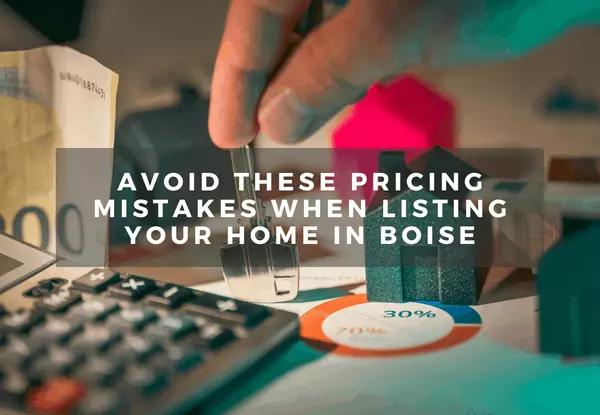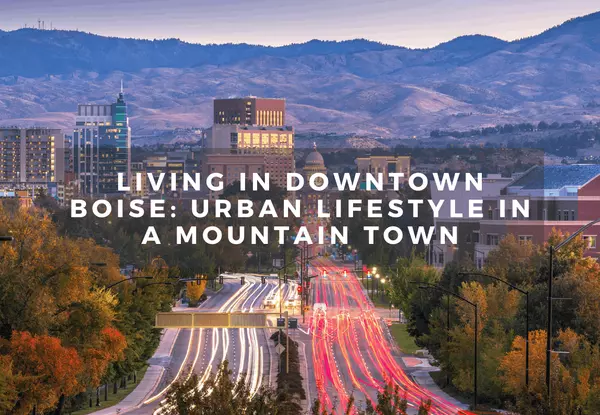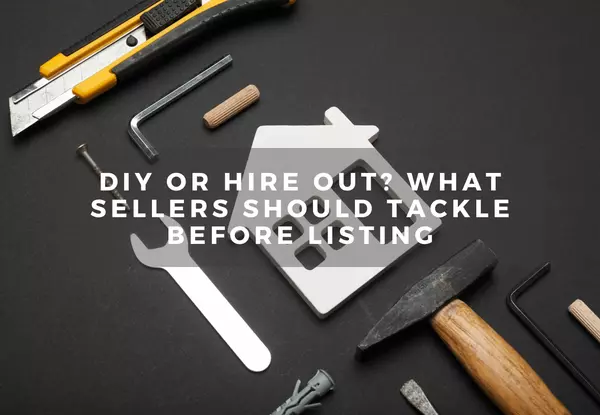11 Costly Mistakes to Avoid When Buying a Home in Boise Idaho
Before you buy a house in the Treasure Valley area, you have to know about these 11 potential problems with buying a home here so you can make sure that you look for them. You know about them. Some of these things are easily solvable, and others are structural problems that you just can't get rid of no matter what you do.
So, before you buy that house here, make sure that you watch this video so you don't get screwed when you're buying a home here in the Boise, Idaho area. In this video, I'm going to go over specifically what you're going to find in resale homes. These are existing resale homes, meaning someone already lives in it, the house was built a number of years ago, and depending on the age of the home, there could be more and more potential problems. But again, there are going to be some things that have nothing to do with the house itself. It has to do with what's coming with the property, but I'm also going to tell you how you can solve some of these things easily, or in other cases, you may just want to move on.
I'm also going to tell you my solution if you don't want to deal with any of these things at the end of this video. My name is Curtis Chisum. I'm a local real estate agent who moved here from San Diego, California. So, if you're looking to relocate here from an area like California, I went through that exact same process, so I know exactly what you're going through—the emotions, the stresses, and what it's like to pick up your whole family and move them to a completely different state.
So, if you're looking to make the move to Boise, Idaho, all you have to do is reach out to me via the contact information on the screen below or in the comment section below as well. I help people all the time, just like you, make the move here to Treasure Valley. I absolutely love it! Reach out anytime—day, night, or weekends—and we'll schedule a Zoom call to go over the right timeline for helping you make the move here to the Boise, Idaho area.
Let's get after these top things you need to know about buying resale homes here in the Treasure Valley. First up is going to be irrigation water rights. That's right, irrigation water rights. If you're coming from a place like California, you're probably not too familiar with this. You're thinking, "What? Don't I just use the domestic water that comes off my house?" No. Typically, here in the Treasure Valley, you're going to actually have separate irrigation water.
Now, some homes won't have irrigation water, and that alone could be a potential red flag for you because it's going to cost you a lot more money to irrigate your property. If you're coming here, maybe you visited before, you've seen videos about the area, you know it's pretty lush and green here. Well, the reason it's lush and green is that there's a lot of irrigation water that occurs because it's actually fairly dry here. It's high desert—2,500 to 2,700 feet elevation. It's dry, high desert, and we have to water a lot to keep our lawns green, but there's so much water around here coming off the mountains in our reservoirs. There's a huge aquifer here as well, so folks that have wells can tap into that. Lots of water. But we have to put that on the ground to make it nice and lush.
So, irrigation water rights are super important. If you don't have irrigation water rights, which does occur specifically in areas around Boise and sometimes Meridian as well, it could cost you quite a bit more to water your property. I was talking to one woman who owns a property in Boise, and she's paying around $400 a month just for water to irrigate her property. Now, if you have irrigation water included, usually it's part of your property taxes, or it might be part of your HOA. It's going to be significantly cheaper. For instance, I'm in Nampa, and I pay $160 for the entire year, essentially via my property taxes. It's a separate bill, but it is technically a tax, and I have unlimited irrigation water to water my lawn and anything outdoors. You don't want to drink this water; it comes from the canal, and you don't know exactly what's in it. However, it's good for watering. So, $160 for unlimited water for the entire year—that's incredibly cheap. But you could be spending a lot if you don't have that.
The other thing you need to know is how is that water being delivered to your property? Is it being delivered via a pressurized water system? And what that means is that there are wells around here—usually, each subdivision has one—and that water is being pumped out of a canal, it's being pressurized, and then piped to your house and run through sprinklers just like you would expect, probably similar to what you might have in California if you happen to have a lawn. That's how it typically works. However, there are a lot of properties that don't have that; they're on a flood system.
So, what the flood system is, is that you have to open a big gate valve. You literally pull open a gate valve, and then that runs through some piping, and it floods your lawn. You usually have access to this once a week, and you're going to have access based on an assigned day and time, kind of based on when you purchased the house. So, anyone that bought before you typically has more senior rights to more preferred days and times. Let me give you a quick example: I have a friend who moved here shortly after me. He bought in Nampa as well, does not have pressurized irrigation, he's on the flood system, and he didn't know this before he bought the house. But he has to get up once a week at midnight. That is his assigned time, and he has six hours that he can flood his lawn. So, he has to wake up at midnight, actually drive around his neighborhood to get to the gate valve, open it up, it floods for a period of about six hours, and then he goes to work. His wife heads out, grabs the kids, and then closes it. One time he forgot to close it, and it flooded part of his house. He said if he had known that before he bought here, he would not have bought that house. He's actually now moving essentially for that main reason.
Now, related to irrigation is that we do have poor drainage and poor soil conditions. It's very clay-type soil here, so water doesn't really percolate through the ground particularly well. So, what can happen is that on your property, you could have a lot of standing water where that water might want to flood off. Technically, in Idaho, it is legally required that you keep water that's on your property within that property and handle it by draining it into the ground itself. Now, some irrigation water runoff is allowed into the street—not a big deal—it's going to hit the storm water drain. Typically, a lot of the subdivisions are going to have storm water retention basins where the water goes into a storm water retention and slowly percolates back down through a sand layer into the aquifer. However, it's very easy to overwater your grass here. It happens all the time where people just overwater like crazy, and then they flood out their properties.
You have to prepare to put in things like dry wells or French drains. These terms are often used interchangeably, and essentially, it's a deep pit with a pipe going down into it that's perforated with gravel around it so the water can flow into it and slowly percolate out. The problem is you have to go deep enough down to really hit flowing water. You have to go down probably 10 to 16 feet to hit flowing water for it to work effectively. So, you need to plan for that or look for homes that already have that installed. Otherwise, there could be water damage on your property or, worse, getting into your crawl space.
Now, let's touch on the crawl space. That is a thing that happens around here: water getting into crawl spaces. It happens with resale homes, and it also happens with new construction homes. There have actually been a couple of big stories recently with a couple of builders here in the Treasure Valley, specifically Hubble and Toll Brothers, where news stories have come out that homeowners are suing those builders—or might be suing the builders—because of water intrusion issues happening in the crawl spaces. Now, I've talked with one of the representatives of one of those companies—a warranty guy—I won't put his name on record, but it sounds like in one particular property, it sounds like they basically dammed up their property with concrete, then overwatered, and then flooded out their own crawl space. But that's something for, I guess, the courts to decide.
You need to watch out for that, and that could cause a lot of problems in your crawl space—very, very expensive. Whether that's resale or new construction, you've got to look out for that. Actually, I just went down before I made this video into my crawl space just to make sure I didn't have any standing water down there because I had heard about some water issues around here in my neighborhood. Totally dry—no problem at all.
Now, what's really cool is that I have a conditioned crawl space, and this is versus an unconditioned crawl space, where a lot of the builders will use this unconditioned crawl space, and then some are using the conditioned crawl space. Now, what that is, is an unconditioned crawl space is probably what you might expect to see, where you have vents located around the side of the crawl space in that perimeter wall. That's going to allow airflow to come in, which helps dry out any potential moisture that could get in. However, it's also a very wide open point of entry for water to get in if it's coming from the outside.
Related to all this, I have to touch on the fact that we do have a very high water table here. In some areas, you're only about 5 feet down before you're going to hit water. In fact, there are areas around here with ponds, and really, those ponds are simply just dug big pits. Essentially, the groundwater came up and created the ponds for some of these luxury communities. Just so you know, those are man-made, and it's groundwater that's coming in. Well, that same groundwater can get into your crawl space as well, whether or not you have a conditioned or unconditioned crawl space.
The conditioned crawl space doesn't have any vents at all, so that's going to help prevent water from getting in. It draws air in from your house—your conditioned air from your house—from the AC and the heater, and that's being circulated through your crawl space to help keep it dry and keep water out as well. However, if you have high groundwater, it's going to come in no matter what, so you just have to be on the lookout for that and prepare for it.
Now, one drawback to a conditioned crawl space that I've heard of is that it is a mechanical ventilation system, meaning that the fan runs 24/7, pulling that air into the crawl space. Someday, that could break—everything breaks eventually—and you may not know because it's very quiet. It's typically in your garage or maybe even the attic where that fan is located, so you have to monitor your crawl space regularly to make sure that nothing's going on. If that fan breaks, there's no airflow any longer. If there's any humidity that builds up, you're going to have a moisture problem.
Now, before we leave crawl spaces, we do need to talk about that silent but deadly gas that occurs sometimes, and that's radon. People don't know much about radon, especially if you're coming from a place like California. I didn’t know about it either, except that my brother lives in Maryland, and they have radon there, so he had to deal with it. Radon is a silent, odorless, deadly gas that leaches out of the ground in some areas of the Treasure Valley. It comes from uranium that's in the soil from decomposed granite, and it does come out in certain areas. However, it's very hit-and-miss whether or not it's there. Some homes could have it, while others may not, even in the same community—it's just sporadic.
Now, I did not test my home before I moved in, but I had a client recently who bought a home two miles from me and tested for radon, and it popped positive. I’ll talk about how to mitigate that. So, I went ahead and tested my home—no problem at all. Those conditioned crawl spaces I talked about are going to help mitigate radon gas, but they aren't specifically designed to mitigate radon. So, if you do have radon, you need to put in a radon mitigation system.
For that particular home, they had a conditioned crawl space, but the fan was not working for some reason. Once they got it working again, it actually took care of the radon for the most part. However, they still installed a radon mitigation system, which is basically an extra layer of Visqueen (a moisture barrier), and they vacuumed the radon gas out from underneath that moisture barrier with another continuously running fan. This solved the problem. You can do these tests yourself—an at-home test costs about $25, or you can have a professional radon test done for a couple hundred dollars.
Another thing to look out for is older roofs here in the Treasure Valley. We do get a lot of wind, snow, and rain, so roofs can wear out a little faster than what you might be used to, especially if you're coming from a place like California. So, you definitely want to make sure to get a roof inspection. A home inspector would take a look at it first, and if they recommend a roof inspection, we'll do that and prepare for maintenance or replacement. If you're buying a resale home, you don’t want any leaks, because you could end up with mold problems.
Similarly, siding can wear out, especially if it's in contact with the ground, and dry rot can occur. These are things you really want to look out for, especially in older homes, but even in new construction homes. For example, when homes are being built, it can rain, and if they close up the home too fast, you might have mold, often in the crawl spaces. I even had mold in my own crawl space when I bought my house. I've had several clients find mold in brand-new construction homes. Fortunately, the builder immediately takes care of it. It's easily remediated, and they often provide extended warranties to ensure no problems.
To help solve moisture and mold problems—whether it's in the attic from an older roof or in the crawl space from potential moisture—you can use spray foam insulation. Spray the entire roof structure, sealing up all the vents. Normally, you have vents to allow moisture to escape, but with spray foam insulation, you're actually keeping moisture out. It acts as a waterproof membrane. The same can be done in the crawl space to prevent moisture and mold growth.
If you're dealing with older homes, you should also watch out for older plumbing, particularly polybutylene piping. It was used pretty predominantly here in the valley, especially in the 1990s, but also in the 1980s and 1970s. Although it was banned in the late '90s, many builders used it because it was cheap. However, it has a lot of problems—chemical reactions between elements in the water and the pipes, especially around turns, can lead to pipe bursts. Re-piping costs range from $8,000 to $15,000, depending on the size of the home.
In addition to plumbing, you also need to inspect HVAC systems, AC units, and furnaces. Water heaters generally last around 10 years, furnaces can go 15-20 years if maintained well, and AC units have similar lifespans. For older homes, budget for replacements accordingly.
In terms of electrical systems, homes built in the '90s and 2000s are probably okay, but much older homes, like Craftsman or Victorian ones, may have outdated wiring, which is a fire hazard. These homes may also lack proper insulation. Even homes built in the 1970s, 1980s, or 1990s might have insulation that has worn out, so you want to check that as well.
For rural properties, septic systems and wells are common. If you're looking for land, you'll need to know about these systems. With a well, you'll need a backup generator in case of power outages.
To solve all these problems, hire an inspector and a qualified real estate agent to guide you through the home-buying process. Whether you’re looking at resale or new construction homes, I’m Curtis Chism, and I’d love to help you out. Reach out by phone, text, or email, and we can set up a Zoom call to figure out a timeline that works for you.
If you're looking to explore more about the Treasure Valley, check out this video for more details.
Categories
Recent Posts










